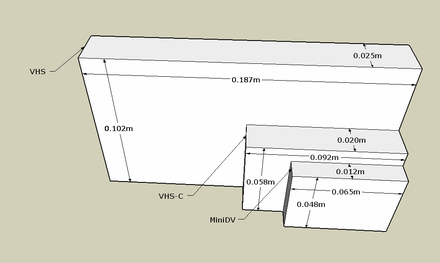VHS-C
This article needs additional citations for verification. (December 2008) |
  | |
 | |
| Media type | Magnetic Tape |
|---|---|
| Encoding | NTSC, PAL |
| Standard | Interlaced video |
| Usage | Home movies |
VHS-C is the compact VHS videocassette format introduced in 1982[1] and used primarily for consumer-grade compact analog recording camcorders. The format is based on the same video tape as is used in VHS, and can be played back in a standard VHS VCR with an adapter.[2] Though quite inexpensive, the format is largely obsolete even as a consumer standard and has been replaced in the marketplace by digital video formats, which have smaller form factors.
The magnetic tape on VHS-C cassettes is wound on one main spool and used a gear wheel which moves the tape forward. It can also be moved by hand. This development hampered the sales of the Betamax system somewhat, because the Betamax cassette geometry prevented a similar development.
VHS-C cassette was larger than Video8 cassette, but was compatible with VHS tape recorders. A higher quality version of VHS-C was released, based on S-VHS, known as S-VHS-C, that competed against Hi8, the higher quality version of Video8. The arrival on the market of inexpensive S-VHS-C camcorders led to the inclusion on many modern VCRs of a feature known as SQPB, or SuperVHS Quasi-PlayBack, but did not make a significant impact on the market as the arrival of MiniDV as a consumer standard made low-cost, digital, near-broadcast quality video widely available to consumers, and rendered analog camcorders largely obsolete.
Compared with Video8, VHS-C had similar video quality but a shorter run time, 90 versus 30 minutes at SP speed (for standard cassettes), 180 versus 60 for longer-running modes. Although at one time JVC marketed a 45-minute and a 60-minute SP Mode tape with the Extra High Grade formulation (135 minutes, and 180 minutes in EP/SLP Mode). Similarly Video8 spawned a 120 minute version of the cassette (240 minutes in long play).

The later Hi8 and S-VHS-C systems both have a quality similar to the laserdisc system.
Although Video8 acquired a digital variant, Digital8, it is extremely unlikely that D-VHS will ever be adapted to a compact format, as the consumer camcorder industry has largely standardized on small-format MiniDV and the new hard drive based recorders. As of 2010, a few VHS-C and S-VHS-C camcorders are still available from JVC at extremely low prices (~US$200), and the media remain widely available at relatively low cost.
Slackening Problem
Early VHS-C cassettes did not have a mechanism to ratchet or lock the supply reel when not in use, making them susceptible to spilling tape inside the shell. Consequently, manufacturers placed a label on their camcorders and adapters to warn the user to check that the tape is not slackened before inserting a cassette. The user could dissipate the slack by manually turning the take-up gear. Later cassettes corrected this problem by adding teeth to the supply reel to lock it in place when no upward pressure is applied. The spindle of the camcorder or VCR supplies pressure to float the reel's turntable and teeth above the shell, allowing it to rotate freely when in use.
Write Protect Imperfection
VHS-C cassettes have a switch to inhibit recording of a cassette. Unfortunately, the state of this switch is not always propagated through every adapter to a VCR (only some adapters have this feature), so accidental erasure of a write-protected cassette is possible if the adapter's write protect lug or switch allows it.
References
- ^ Following page by the inventors of VHS gives the release date of VHS-C as 1982 and includes details of first VHS-C recorder (the HR-C3): "1982 VHS-C". Victor Company of Japan Ltd. (JVC). "Copyright 2001-2003". Retrieved 2007-08-06.
HR-C3 The first model of portable VCR to use VHS-C cassette
{{cite web}}: Check date values in:|year=(help) [dead link] - ^ http://www.videointerchange.com/video-history.htm#VHS
